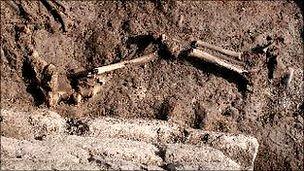Northumberland Roman fort's child murder mystery
- Published

The bones were at first thought to be those of a dog
Archaeologists believe they have uncovered an 1,800-year-old murder mystery in Northumberland.
During a dig at Vindolanda Roman fort, the skeleton of a child, aged between eight and 10, was found in a shallow pit in the corner of a barrack-room.
Foul play is suspected, because human burials in built-up areas were strictly forbidden in Roman times.
It is thought the remains were those of a girl, and the position indicates that her hands could have been tied.
When the bones were first discovered, it was at first thought they were those of a large dog.
However, examinations by experts at Durham University revealed that they were the remains of a child.
The pit in the barracks has been dated to the middle of the 3rd Century, when the Fourth Cohort of Gauls formed the garrison.
At that time the dead had to be interred or cremated in cemeteries on the outskirts of towns or barracks, so the concealment of a body in this fashion would have been a criminal act.
Andrew Birley, Vindolanda's director of excavation, said that it was not the first time an excavation of a Roman fort alongside Hadrian's Wall had uncovered a murder victim.
"In the 1930s my grandfather, Eric Birley, found two skeletons concealed below a floor in a civilian building at Housesteads.
"One had the blade of a knife stuck in the ribs, and the later coroner's inquest duly produced a verdict of murder by person or persons unknown, shortly before AD367.
"I'm sorry to say that Vindolanda has probably produced another Roman murder victim.
"I shudder to think how this young person met their fate."
Once the forensic examination at Durham University has been completed, the skeleton will be put on view at Vindolanda Museum.